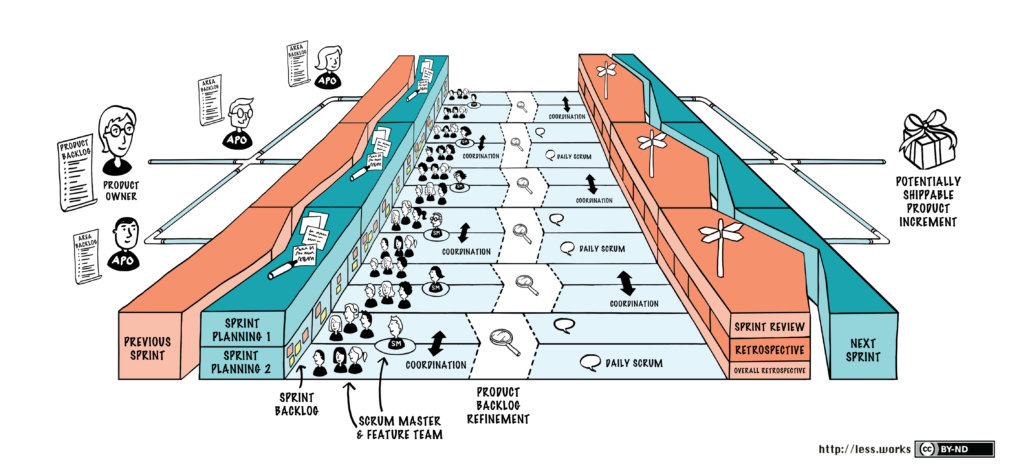
A Comprehensive Overview of Large Scale Scrum (LeSS)
Large Scale Scrum (LeSS) is a framework for scaling Scrum to large organizations. Similarly to Nexus, it is based on the same principles as Scrum, but it adapts those principles to work with multiple teams.
LeSS can help organizations to increase throughput, improve quality, and reduce risk. However, it is a complex framework and requires careful planning and execution.
LeSS Principles
LeSS is based on nine principles that guide its implementation. These principles are:
- Transparency: All work should be transparent to all stakeholders. This includes the product backlog, the sprint backlog, and the progress of the team.
- Inspection: The team should regularly inspect its work to identify any defects or problems. This can be done through daily Scrums, sprint reviews, and sprint retrospectives.
- Adaptation: The team should adapt its process based on the results of its inspections. This means being willing to change the way it works to improve its results.
- Whole product focus: The team should focus on delivering the entire product, not just individual features. This helps to ensure that the product is cohesive and meets the needs of the customer.
- Customer centricity: The team should always keep the customer in mind when making decisions. This means understanding the customer’s needs and expectations, and delivering a product that meets those needs.
- Empirical process control: The team should use empirical data to make decisions about its process. This means tracking its progress and making changes based on the results.
- Systems thinking: The team should view the product and its development as a system. This helps to identify and understand the relationships between different parts of the system.
- Lean thinking: The team should use lean principles to improve its efficiency and effectiveness. This means eliminating waste and focusing on value creation.
- Queuing theory: The team should use queuing theory to understand and manage its workload. This helps to ensure that the team is not overloaded and that it can deliver its work on time.
LeSS Framework Structure
There are two main LeSS frameworks: Basic LeSS and LeSS Huge.
Basic LeSS
Basic LeSS is a good choice for organizations that are developing large products with up to eight teams. It uses a single product backlog, a single sprint goal, and synchronized sprints.
LeSS Huge
LeSS Huge is a good choice for organizations that are developing very large products with more than eight teams. It uses multiple product backlogs, multiple sprint goals, and asynchronous sprints.

LeSS Guides and Experiments
In addition to the two main frameworks, there are also a number of LeSS Guides and Experiments. These Guides and Experiments provide additional information and guidance on how to use LeSS.
LeSS Guides
The LeSS Guides are a set of documents that provide more detailed information on how to use LeSS. They cover topics such as team sizing, scaling the product backlog, and managing dependencies.
LeSS Experiments
The LeSS Experiments are a set of practices and techniques that can be used to scale Scrum. They are not part of the core LeSS framework, but they can be used to customize LeSS to fit the needs of a particular organization.
Roles, Artifacts, and Events in LeSS
The LeSS framework defines a number of roles, artifacts, and events that are used to scale Scrum to large organizations.
Roles
Similarly to the non-scaled Scrum, the main roles in LeSS are the Product Owner, the Scrum Master, and the Development Teams.
- The Product Owner is responsible for the product vision and backlog.
- The Scrum Master is responsible for facilitating the Scrum process and removing impediments.
- The Development Teams are responsible for developing the product.
Artifacts
The main artifacts in LeSS are the product backlog, the sprint backlog, and the increment.
- The product backlog is a list of all the work that needs to be done to complete the product.
- The sprint backlog is a list of the work that will be done in the next sprint.
- The increment is the working product that is produced at the end of each sprint.
Events
The main events in LeSS are the Sprint Planning, the Daily Scrum, the Sprint Review, and the Sprint Retrospective.
- The Sprint Planning is a meeting where the team plans the work for the next sprint.
- The Daily Scrum is a short meeting where the team synchronizes its work and identifies any impediments.
- The Sprint Review is a meeting where the team presents the increment to the stakeholders.
- The Sprint Retrospective is a meeting where the team reflects on the past sprint and identifies improvements that can be made.
Essential Components of Large Scale Scrum (LeSS)
There are five essential components of LeSS:
- Single Product Backlog: The product backlog is a list of all the work that needs to be done to complete the product. In LeSS, there is a single product backlog for the entire project. This helps to ensure that all teams are working on the same priorities and that the product is developed in a cohesive way.
- Shared Definition of Done: The Definition of Done is a set of criteria that defines when work is considered to be complete. In LeSS, the Definition of Done is shared by all teams. This helps to ensure that all teams are working towards the same standards and that the product is of high quality.
- Synchronized Sprints: In LeSS, all teams start and end their sprints at the same time. This helps to ensure that the teams are aligned and that the product is delivered on time.
- Cross-functional Teams: In LeSS, teams are cross-functional, meaning that they have all the skills necessary to complete the work. This helps to reduce dependencies between teams and to improve the efficiency of the development process.
- Frequent Communication: In LeSS, teams communicate frequently with each other and with the Product Owner. This helps to ensure that everyone is on the same page and that the product is developed according to the needs of the stakeholders.
These five essential components are the foundation of LeSS. By following these components, teams can scale Scrum to large organizations and deliver high-quality software on time and within budget.
What’s Different in LeSS?
LeSS is significantly different from SAFe, another agile scaling framework we have extensively discussed. For example, it requires less roles and layers of governance, it’s less formulaic and, generally speaking, it has a lighter nature.
Leaving aside the many common elements, there are also a number of key differences between LeSS and Scrum:
- Multiple teams: LeSS works with multiple teams, while Scrum is typically used with a single team.
- Larger product backlog: The product backlog in LeSS is typically larger than the product backlog in Scrum.
- More complex dependencies: LeSS can have more complex dependencies between teams than Scrum.
- Increased communication requirements: LeSS requires more communication between teams than Scrum.
These differences can make LeSS a more complex framework than Scrum. However, LeSS can also offer a number of benefits, such as increased throughput, improved quality, and reduced risk.
Benefits and Drawbacks of Large Scale Scrum
There are a number of benefits to using LeSS. These include:
- Increased throughput: LeSS can help organizations to deliver more features in less time.
- Improved quality: LeSS can help organizations to produce higher-quality software.
- Reduced risk: LeSS can help organizations to reduce the risk of defects and delays.
- Increased transparency: LeSS can help organizations to improve communication and visibility across the development team.
- Improved communication: LeSS can help organizations to improve communication and collaboration between teams.
However, there are also some drawbacks. These include:
- Increased complexity: LeSS is a more complex framework than Scrum.
- Increased coordination overhead: LeSS requires more coordination between teams.
- Increased training requirements: LeSS requires more training for teams and stakeholders.
The decision of whether to use LeSS depends on the specific needs of the organization.
When does LeSS fit?
LeSS can be a good fit for organizations that meet the following criteria:
- The organization is developing a large product.
- The organization needs to increase throughput and improve quality.
- The organization is willing to invest in training and coordination.
- If an organization meets these criteria, then LeSS can be a good way to scale Scrum and deliver high-quality software on time and within budget.
Steps for a Successful Implementation
A successful implementation of LeSS requires careful planning and execution. Here are some steps that organizations can take to ensure a successful implementation:
- Start small. It is not advisable to start with a large number of teams. Start with a small number of teams and gradually increase the number of teams as the organization becomes more familiar with LeSS.
- Get buy-in from stakeholders. It is important to get buy-in from all stakeholders, including the Product Owner, the Scrum Masters, the Development Teams, and the management team.
- Provide training. It is important to provide training to all stakeholders on the LeSS framework. This training should cover the principles, practices, and roles of LeSS.
- Start with a pilot project. It is a good idea to start with a pilot project to test out LeSS before rolling it out to the entire organization. This will help to identify any potential problems and make sure that LeSS is a good fit for the organization.
- Be patient. It takes time to implement LeSS successfully. Don’t expect to see results overnight. Be patient and give LeSS time to work its magic.
By following these steps, organizations can increase their chances of a successful implementation of LeSS.
Conclusion
Large Scale Scrum (LeSS) is a powerful framework for scaling Scrum to large organizations. It is based on the same principles as Scrum, but it adapts those principles to work with multiple teams. LeSS can help organizations to increase throughput, improve quality, and reduce risk. However, it is a complex framework and requires careful planning and execution.
If you are considering using LeSS in your organization, be sure to do your research and understand the benefits and drawbacks of the framework. You should also start small and gradually increase the number of teams as you become more familiar with LeSS.
Do not forget to share this article if you found it helpful!
Italian-German cloud computing professional with a strong background in project management & several years of international work experience in IT & business consulting. His expertise lies in bridging the gap between business stakeholders & developers, ensuring seamless project delivery.

